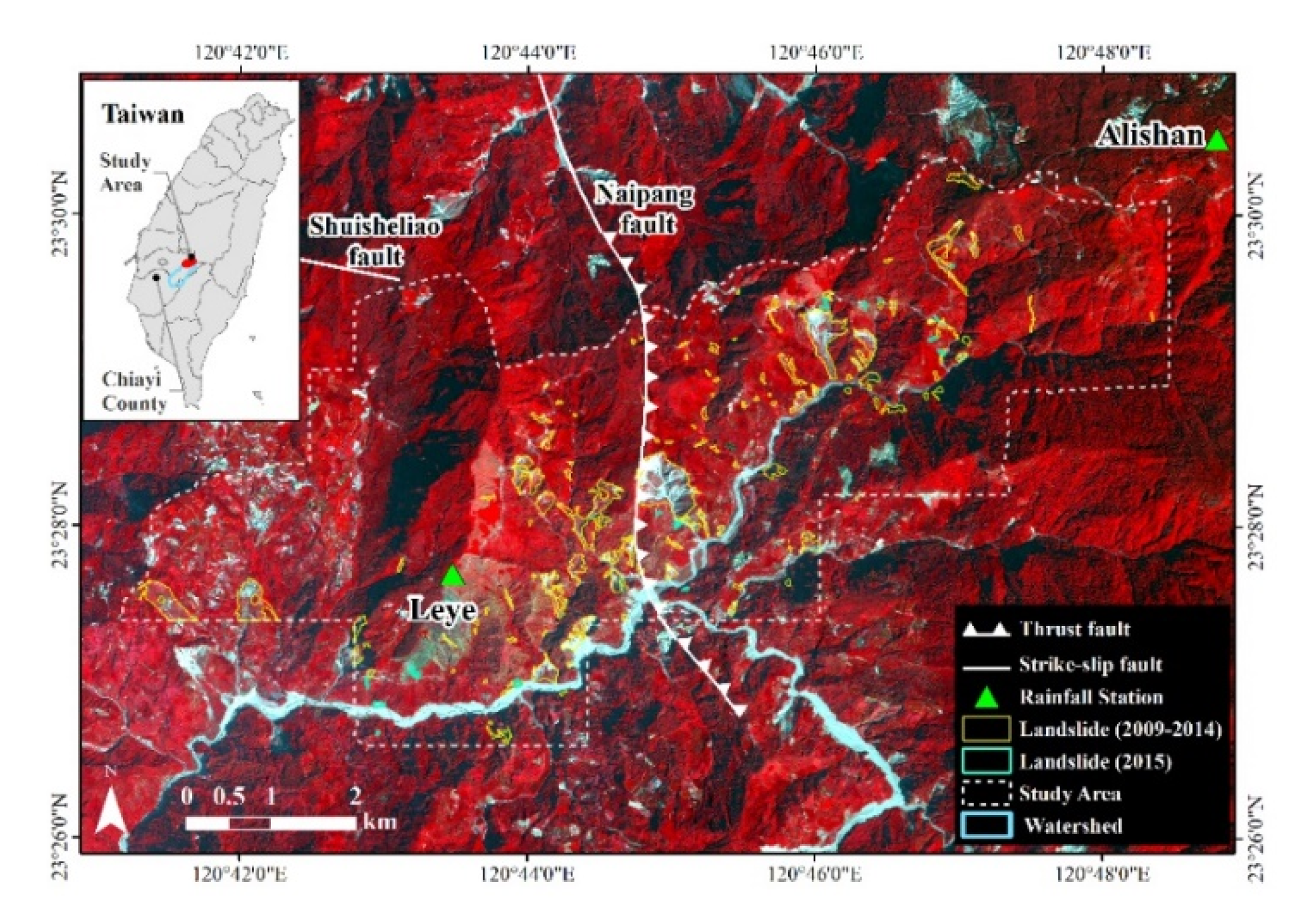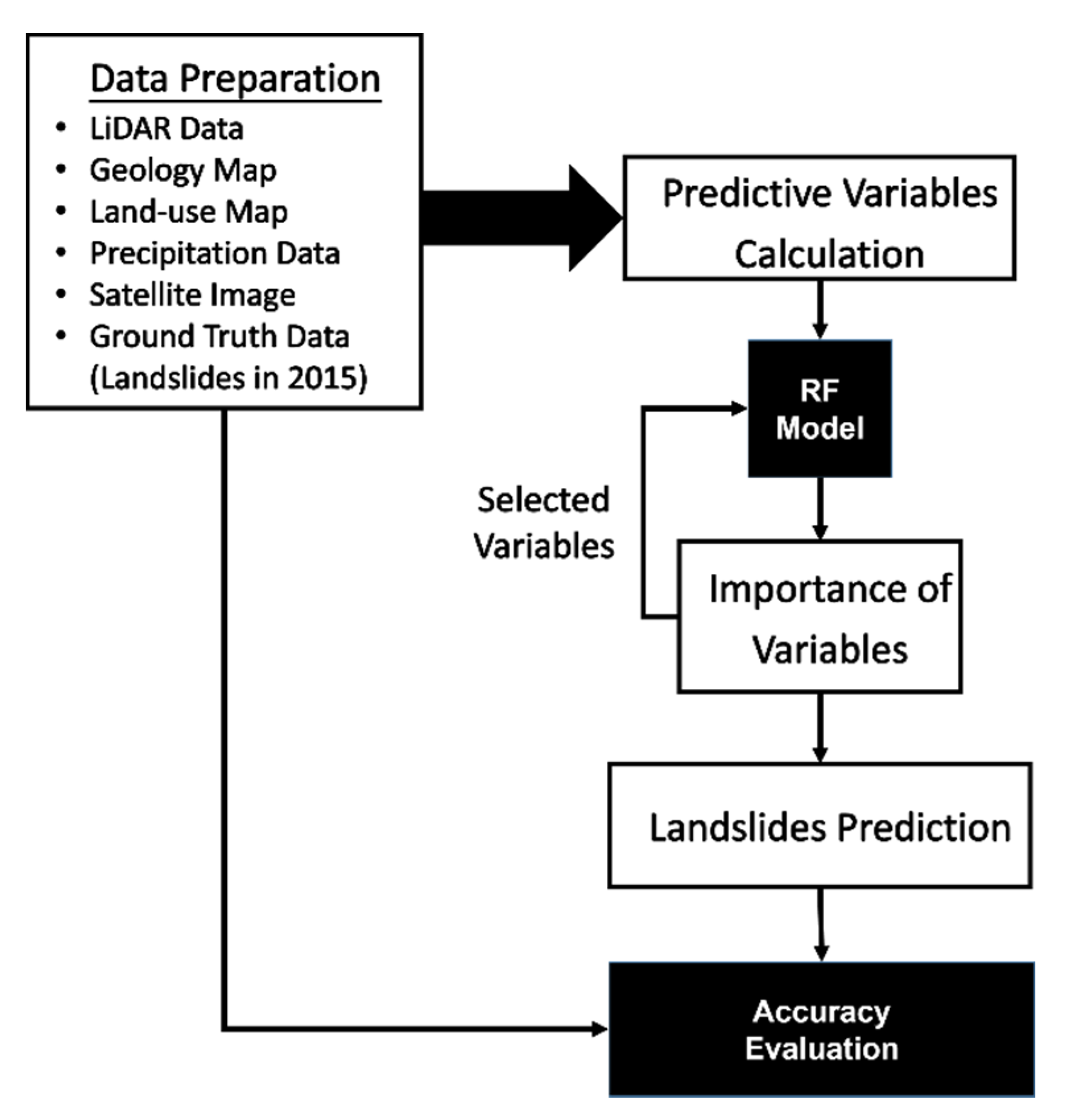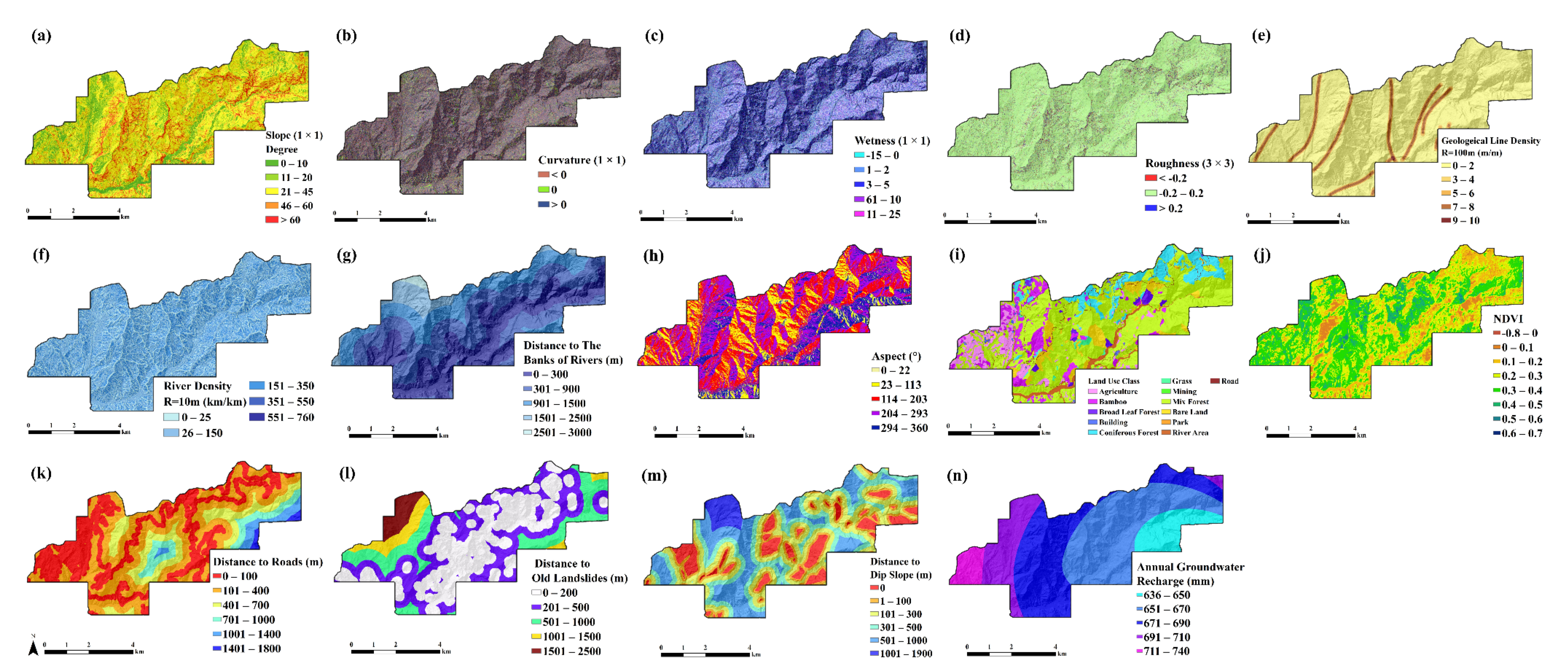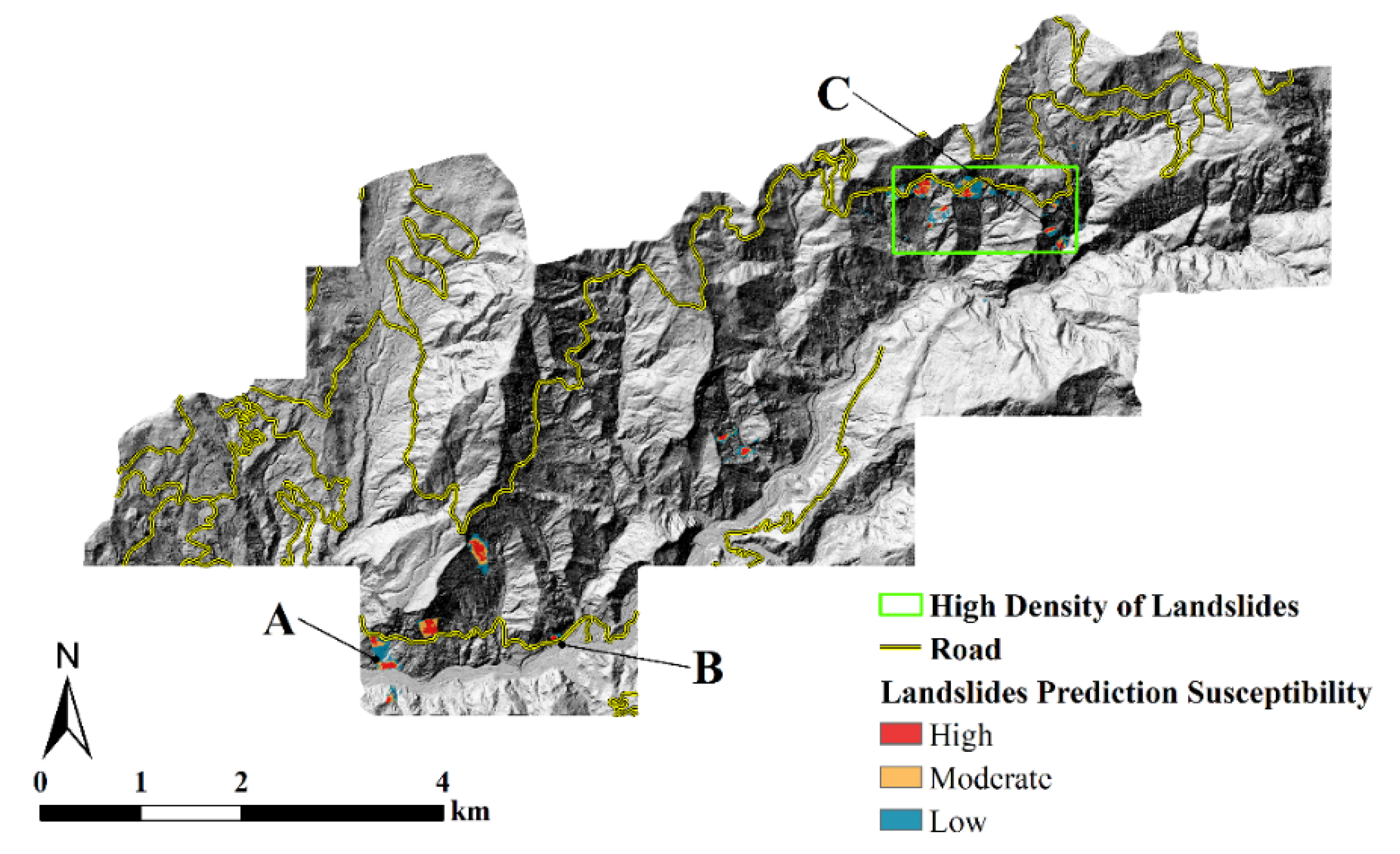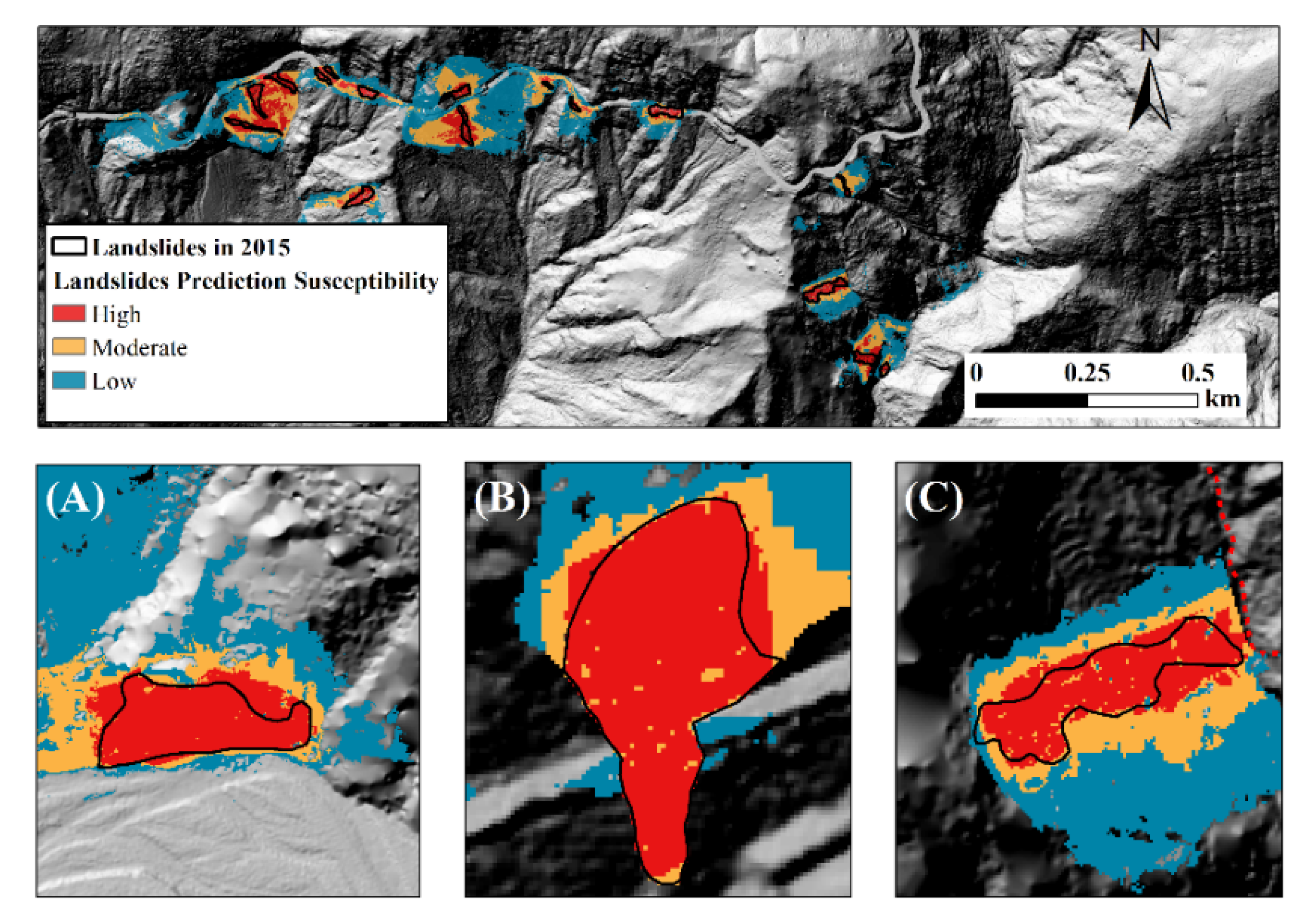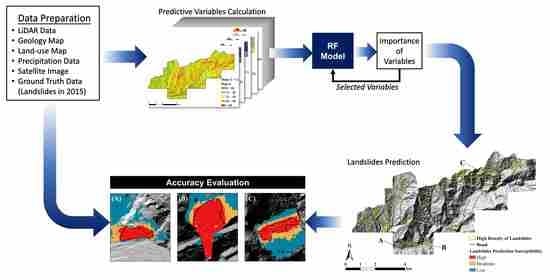1. Introduction
Landslides are the fifth-deadliest natural disaster after windstorms, floods, earthquakes, and extreme temperature during the last 20 years [
1]. Globally, they occur over a wide range of spatial and temporal scales across mountainous landscapes. Landslides are driven by gravity and are characterized by movements of solid rock, debris, and soil, causing severe human casualties, property loss, and infrastructure and environmental damage [
2,
3,
4]. Landslides are often triggered by other natural disasters, including heavy precipitation and earthquakes. In recent years, due to the impacts of climate change and rapid population growth, coupled with the increased frequency and intensity of typhoons, storms, and hurricanes, landslide-related casualties have significantly increased, especially in less-developed and developing countries where slope cultivation and agriculture are commonly practiced [
5,
6,
7].
Landslides are also severe in Taiwan and considered a major natural hazard in hilly and mountainous regions. They cause risk to life and infrastructure and are difficult to predict. Taiwan’s mountainous area accounts for roughly 70% of the country’s total land area. The majority of the population is concentrated in alluvial plains and basins. Due to population growth, pressures on narrow residential areas often lead to urban expansion into hilly and sloped areas that are critically prone to landslides. On the other hand, because Taiwan is located at the subduction zone of the Philippine Sea and Eurasian Plates, collisions between these two plates have resulted in many folds and faults in the formed mountains. In addition, the country often experiences typhoons and storms during the rainy season due to the effects of the western North Pacific typhoon belt. Along with a lack of ecological protection and soil conservation as well as improper hillside development for agriculture, landslides often occur, blocking roadways, isolating mountain areas, injuring people, and damaging property [
8].
A number of studies using machine-learning algorithms, such as random forests (RF), support vector machines (SVMs), and decision trees, have been implemented for landslide monitoring [
9,
10,
11]. The RF method, recently developed to deal with large, complex data, is considered to be a superior classification algorithm and has been widely used in various fields of data mining [
12,
13]. Various parameters are often adopted to analyze landslide susceptibility, such as geology, soil depth, soil type, and land-use/land-cover (LULC) types [
14,
15,
16,
17]. However, the use of these datasets usually reveals the limitations of availability and scale [
18]. Therefore, the evaluation of landslide areas based on a digital elevation model (DEM) has been widely conducted, assuming that topographical factors are more efficient. The LiDAR data are thus used in this study to generate high-resolution DEM data. Studies also found that landslide prediction performance decreases with finer resolutions [
19], while changes in landside prediction parameters with a spatial scale have a significant effect on the results [
20,
21,
22].
The main objective of this study is to develop a RF-based approach using different spatial datasets with different scales to predict landslide areas in the Tsengwen River Watershed (TRW), Taiwan. The results in the form of spatial and quantitative landslide information could be valuable for devising successful institutional interventions and management plans to minimize the risk of landslides in the region.
2. Study Area
The study region, located upstream of TRW, Taiwan, covers approximately 40 km
2 (
Figure 1). The elevation of the region ranges between 700 and 2400 m above sea level. More than 20% of the total area has a slope greater than 45°. The region is surrounded by the Naipan, Shuisheliao, and Kantzuchai faults, the lithology of which is characterized by shale, sandstone, and interlayered sandstone and mudstone from the mid-Miocene to Pleistocene [
23]. The average annual precipitation at the Leye meteorological station (low altitude) and Alishan station (high altitude) is approximately 3382 mm and 4267 mm, respectively. Landslides, recognized as one of the costliest natural disasters in the region, frequently occur in response to a number of natural events, including heavy rainfall and earthquakes, and anthropogenic events, such as building or road construction. For example, the area of landslides in the study region, caused by typhoon Morakot on 8 August 2009, was roughly 1.2 km
2 during 2009–2010, while the new landslide areas in 2015 increased at least 0.04 km
2.
3. Data Collection
A suit of datasets, collected from the Council of Agriculture and the Central Geological Survey, Taiwan, was used for landslide prediction, including landslide inventory maps, LULC maps, geological maps, LiDAR data (March 2015), SPOT5 (March 2015), and precipitation data. The landslide maps collected from the Forestry Bureau and Council of Agriculture, Taiwan, were primarily constructed using high resolution satellite images from 2009 to 2015 with an area greater than 0.1 ha. The landslide patches had been validated using field survey data conducted by the Central Geological Survey, Taiwan. Lastools software was used to generate the digital elevation model (DEM) (1 m resolution) for topographic analysis. The precipitation data from 14 weather stations around the study region, collected from the Taiwan Central Weather Bureau during 2011 to 2014, were used to evaluate the effects of annual rainfall on groundwater charging.
4. Methodology
A flowchart of the methodology illustrates the main steps in data processing used in this study to predict landslide areas in the region (
Figure 2).
4.1. Random Forests
The RF algorithm [
24], which is an ensemble learning method developed by combining predictions from decision trees, was applied to build the regression or classification model. This method has several advantages. For example, it is a more commonly used in a multivariate regression or classification method, and assumptions on the distribution of explanatory variables are not required. Likewise, the mixed use of categorical and numerical variables without resorting to the use of indicator (or dummy) variables is allowed, and interactions and non-linearities between variables can be accounted for [
25]. The RF has been widely applied in many fields with excellent performance [
13,
26,
27]. It has also achieved good results in landslide prediction and landslide location identification [
26,
28]. In this study, the KNIME Analytics Platform was used to construct the RF prediction model. The data were divided into two groups of pixels, namely training pixels (30%) and evaluation pixels (70%), for accuracy assessment. For building the RF model, 50% of the group of training pixels were randomly extracted and used as training samples for model establishment, leaving 50% of the data for model validation.
4.2. Predictive Variables
Predictor variables used in this study can be categorized into three groups, namely topographic, hydrological, and geological (
Table 1). Topographic variables, derived from DEM, include aspect, river density, slope, curvature, wetness, and roughness. Hydrological variables, derived from GIS layers of river and road networks, include the distance to banks of rivers, distance to roads, and river density. Geological variables, derived from geological maps, comprise geological density line, distance to banks of old landsides, and distance to dip slope. The slope, curvature, wetness, and roughness were calculated for different moving window sizes (i.e., 3 × 3, 5 × 5, 7 × 7, 9 × 9, and 11 × 11) to investigate the scale effects of these topographic variables on the results. Likewise, different radiuses (R) for geological line density and river density were also calculated for the analysis of search effects using the Line Density tool in ArcGIS. The LULC classes, Normalized Difference Vegetation Index (NDVI), and annual ground water recharge were used. In total, 36 variables were derived and used in this study for building a landslide prediction model.
Figure 3 shows the spatial variations of predictor variables in this study. Specifically, the slope and curvature were calculated using the quadratic approximation method [
29], and the wetness factor quantifying the topographic control of the hydrological processes was estimated from the catchment area (
As) using terrain analysis using DEM as follows:
The roughness and density of the geological line structures, respectively, characterizing the surface characteristics of the terrain, were calculated from DEM [
30]. The river density, indicating the drainage system, was also calculated from DEM using ArcGIS’s hydrology toolset.
The distance to river banks, distance to roads, and distance to old landslides, characterizing the erosion extension and the strength and stability at the foot of the slope, were calculated using the Euclidean distance. The aspect, calculated from DEM using ArcGIS’s aspect tool, indicates a slope’s horizontal direction [
31], potentially causing landslides with increasing probability by torrential rain or incident solar radiation [
32,
33]. The LULC types (12 classes) were extracted from the LULC map, and NDVI was calculated from the SPOT-5 image. The distance to the dip slope was adopted as one variable by the dip slope map from the Taiwan Ministry of Economic Affairs [
23]. The groundwater level of the slope can be estimated from long-term annual precipitation data, evapotranspiration data, and base flow data [
34] using the following equation:
where QR, BFI, P, and ET are groundwater recharge, base-flow index, precipitation, and evapotranspiration, respectively.
4.3. Accuracy Assessment
The Gini index algorithm [
35] was used for evaluating the importance of 36 predictor variables. The variables that had an importance level greater than 0.1 were used to build the RF model. The results of landslide prediction achieved from this model were also compared with those from the model using 36 variables for the sake of performance comparison between these two models. For accuracy assessment of the predicted landslide areas, the receiver operation curve (ROC) was applied to evaluate the prediction ability of the model. The area under the ROC (AUC) with the higher value indicates a more effective prediction [
36]. A pixel-by-pixel comparison between the predicted landslide areas and the ground reference data was also implemented using a group of evaluation pixels (i.e., 70% of the reference landslide map). To facilitate this comparison, the predicted landslide results were first categorized into the two classes of landside areas and non-landslide areas. The results of the landslide prediction were then verified by comparing pixels from the group of pixels (used for accuracy assessment) with those synchronized from the RF prediction map. The error matrix, using overall producer and user accuracies, and the Kappa coefficient were calculated to measure the prediction accuracy.
5. Results and Discussion
5.1. Importance of Predictive Variables
The results of the sensitivity analysis indicated that 11 out of the 36 variables had probability values greater than 0.1 (
Table 2). They were the LULC type, recharge of ground water, distance to river banks, distance to old landslides, distance to dip slope, geological line density (R = 100 m), distance to roads, geological line density (R = 500 m), river density (R = 100 m), aspect, and slope (3 × 3). The LULC type, recharge of ground water, and distance to river banks were the three most important variables for landslide modeling, with probability values ranging from 0.47 to 0.51. The reasons were that urbanization accelerated the change of LULC type in mountainous areas, transforming soil erosion resistance ability and permeability simultaneously [
37], while the recharge of ground water and the shorter distance to river banks [
38] could respectively change the pore pressure and increase soil erosion in slope areas, consequently triggering landslides [
39,
40]. The distances to old landslides and dip slope had the same value of 0.3, which was attributable to the fact that the areas surrounded by old landslides and dip-slope landslides were highly concentrated [
41] due to the strike of the slope face and the strata being parallel to the intersection angle within 20° [
42], which might potentially cause dip-slope landslides.
The probability values of 0.2 were observed for geological line density (R = 100 m), distance to roads, river density (R = 100 m), and geological line density variables. Geological factors related to faults and folds are highly sensitive for predicting landslides. Likewise, the development of roads in mountainous areas, where the density of debris flows was especially observed, could decrease the stability at the foot of the slope and influence flow paths [
43], thereby increasing the probability of landslides. The topographic factors of aspect and slope (3 × 3) revealed the lower value of 0.14, because the horizontal direction was windward or to the sunny side [
31] in the study area, and a steep slope with a windward or sunny side aspect could cause potential landslides with increasing probability caused by torrential rain or incident solar radiation [
32,
33]. Broadly speaking, NDVI and topographical variables (wetness, roughness, and curvature) were less important than LULC types, or hydrological and geological factors for RF modeling of landslides. Moreover, the results also revealed that a coarser window size, such as slope (3 × 3), wetness (7 × 7), and roughness (9 × 9) or longer search radiuses, such as river density (R = 100 m), could yield more accurate predictions of landside areas. The topographical variables (1 m resolution) were not identified as effective and sensitive variables for landslide modeling, although they spatially characterized more details of the study region. The larger moving windows, which could filter the noise of terrain data, were deemed more effective for modeling of potential landslide areas.
5.2. Accuracies of RF Model and Predicted Landslide Results
The results, achieved from the RF model validation using 36 and 11 variables indicated close agreement between the predicted and actual values in both cases (
Table 3). The overall accuracies and Kappa coefficients obtained for the model using 36 variables were 99.5% and 0.99, while slightly more accurate results were observed for the model using 11 values with an overall accuracy of 99.7% and 0.99, respectively. The use of 11 variables for RF modeling could improve the landslide prediction of 0.2% and 0.1% of the overall and user’s accuracies, respectively. The model coefficients, obtained from the model using 11 variables derived from the sensitivity analysis, were used for predicting susceptibility landslide areas. The predicted results with probabilistic values from 0.5 to 1 could be categorized into three classes to depict landslide susceptibility in the study region, including low susceptibility (0.5–0.7), moderate susceptibility (>0.7–0.9), and high susceptibility (>0.9–1) (
Figure 4). In general, the distributions of predicted susceptibility landslide areas were spatially comparable with those from the ground reference map (
Figure 1). The high susceptibility landslide areas were mostly concentrated in relatively steep slopes located along main roads (
Figure 4), where sites composed of weak or fractured materials could easily experience landslides due to heavy rain. An example illustrates three enlarged sites (A, B, and C) and a high density landside region (green rectangle), which were located in steep slopes along main roads (
Figure 4 and
Figure 5). Broadly speaking, the high susceptibility landslide areas were accurately predicted from the RF model using 11 selected variables showing spatially comparable distributions with the ground reference data.
The predicted results of high-susceptibility landslides, compared with the ground reference data (i.e., group of pixels used for accuracy assessment), indicated the satisfactory overall accuracy of 91.4% and the AUC of 98%. The Kappa coefficient, measuring the difference between actual agreement and agreement expected by chance, was 0.8, confirming the reliability of the RF model for landslide modeling. Of the 70% of the reference pixels used to measure the per-class accuracy of predicted landslide and non-landslide areas, the producer’s accuracy was 99.2%, indicating that only 0.8% of the landslide pixels were omitted from the interpretation results. The lower user accuracy was observed for the non-slide class (85.7%), a corollary to the commission error of 14.3%. For instance, the three enlarged sites (A, B, and C) showed misclassified landslide areas (commission errors) between the predicted landslides and the ground reference landslides in 2015 (
Figure 5). The reasons for such commission errors were mainly attributed to the resolution bias between the ground reference map and the predicted landslide map. In this study, the ground reference data were constructed from high resolution aerial photos and field surveys, while the predicted landslide map was generated by the RF model using predictor variables spatially resampled from various datasets with the same or coarser spatial resolutions. The accuracy assessment performed using data with different spatial resolutions could exaggerate the commission and omission errors of the predicted landslide results.
6. Conclusions
The findings achieved from this study validated our RF-based approach for landslide prediction in TRW, Taiwan, using optimal hydrological, geological, and topographical variables and moving window sizes. The results of the sensitivity analysis indicated that 11 out 36 variables, including LULC types, recharge of ground water, distance to the banks of rivers, distance to old landslides, distance to dip slope, geological line density (R = 100 m), distance to roads, geological line density (R = 500 m), river density (R = 100 m), aspect, and slope (3 × 3), were more important factors in the landslide prediction model. The results of landslide prediction, verified with the ground reference data, indicated an AUC of 98%, overall accuracy of 91.4%, and a Kappa coefficient of 0.83, respectively. Although the resolution bias between the ground reference and predicted maps exaggerated the landslide mapping accuracy, the methods used in this research work could provide reliable spatial and quantitative information on landslides in the study region. Such information could be valuable to policymakers to evaluate and formulate their interventions for landslide preparedness, mitigation, and management.
Author Contributions
Conceptualization: Y.-S.C. and T.-T.Y.; methodology: Y.-S.C.; validation: Y.-S.C. and N.-T.S.; data curation: Y.-S.C.; result analysis: Y.-S.C.; writing—original draft preparation: Y.-S.C.; writing—review and editing: N.-T.S. and T.-T.Y.; visualization: Y.-S.C.; supervision: T.-T.Y. with contribution from all coauthors. All authors have read and agreed to the published version of the manuscript.
Funding
This research received no external funding.
Institutional Review Board Statement
Not applicable.
Informed Consent Statement
Not applicable.
Data Availability Statement
The data are not publicly available due to copyright.
Acknowledgments
The LiDAR datasets were provided by the Chung Hsing Surveying Company Limited, respectively.
Conflicts of Interest
The authors declare no conflict of interest.
References
- CRED and UNDRR. Human Cost of Disaster, an Overview of the Last 20 Years 2000–2019; UNDRR: Geneva, Switzerland, 2020. [Google Scholar]
- Shahabi, H.; Hashim, M. Landslide Susceptibility Mapping Using GIS-Based Statistical Models and Remote Sensing Data in Tropical Environment. Sci. Rep. 2015, 5, 1–15. [Google Scholar] [CrossRef] [Green Version]
- Lee, S. Application and Verification of Fuzzy Algebraic Operators to Landslide Susceptibility Mapping. Environ. Geol. 2007, 52, 615–623. [Google Scholar] [CrossRef]
- Haneberg, W.C.; Cole, W.F.; Kasali, G. High-Resolution Lidar-Based Landslide Hazard Mapping and Modeling, UCSF Parnassus Campus, San Francisco, USA. Bull. Eng. Geol. Environ. 2009, 68, 263–276. [Google Scholar] [CrossRef]
- Douglas, I. Hydrological Investigations of Forest Disturbance and Land Cover Impacts in South-East Asia: A Review. Philos. Trans. R. Soc. B Biol. Sci. 1999, 354, 1725–1738. [Google Scholar] [CrossRef] [Green Version]
- Alcántara-Ayala, I. Geomorphology, Natural Hazards, Vulnerability and Prevention of Natural Disasters in Developing Countries. Geomorphology 2002, 47, 107–124. [Google Scholar] [CrossRef]
- Schulz, W.H. Landslide Susceptibility Revealed by LIDAR Imagery and Historical Records, Seattle, Washington. Eng. Geol. 2007, 89, 67–87. [Google Scholar] [CrossRef]
- Lee, D.H.; Lai, M.H.; Wu, J.H.; Chi, Y.Y.; Ko, W.T.; Lee, B.L. Slope Management Criteria for Alishan Highway Based on Database of Heavy Rainfall-Induced Slope Failures. Eng. Geol. 2013, 162, 97–107. [Google Scholar] [CrossRef]
- Conforti, M.; Pascale, S.; Robustelli, G.; Sdao, F. Evaluation of Prediction Capability of the Artificial Neural Networks for Mapping Landslide Susceptibility in the Turbolo River Catchment (Northern Calabria, Italy). Catena 2014, 113, 236–250. [Google Scholar] [CrossRef]
- Saito, H.; Nakayama, D.; Matsuyama, H. Comparison of Landslide Susceptibility Based on a Decision-Tree Model and Actual Landslide Occurrence: The Akaishi Mountains, Japan. Geomorphology 2009, 109, 108–121. [Google Scholar] [CrossRef]
- Tsai, F.; Lai, J.-S.; Chen, W.W.; Lin, T.-H. Analysis of Topographic and Vegetative Factors with Data Mining for Landslide Verification. Ecol. Eng. 2013, 61, 669–677. [Google Scholar] [CrossRef]
- Cutler, D.R.; Edwards, T.C.; Beard, K.H.; Cutler, A.; Hess, K.T.; Gibson, J.; Lawler, J.J. Random Forests for Classification in Ecology. Ecology 2007, 88, 2783–2792. [Google Scholar] [CrossRef] [PubMed]
- Diaz-Uriarte, R.; Alvarez de Andres, S. Gene Selection and Classification of Microarray Data Using Random Forest. BMC BioInform. 2006, 7, 3. [Google Scholar] [CrossRef] [PubMed] [Green Version]
- Taalab, K.; Cheng, T.; Zhang, Y. Mapping Landslide Susceptibility and Types Using Random Forest. Big Earth Data 2018, 2, 159–178. [Google Scholar] [CrossRef]
- Xiong, K.; Adhikari, B.R.; Stamatopoulos, C.A.; Zhan, Y.; Wu, S.; Dong, Z.; Di, B. Comparison of Different Machine Learning Methods for Debris Flow Susceptibility Mapping: A Case Study in the Sichuan Province, China. Remote Sens. 2020, 12, 295. [Google Scholar] [CrossRef] [Green Version]
- Bordoni, M.; Meisina, C.; Valentino, R.; Lu, N.; Bittelli, M.; Chersich, S. Hydrological Factors Affecting Rainfall-Induced Shallow Landslides: From the Field Monitoring to a Simplified Slope Stability Analysis. Eng. Geol. 2015, 193, 19–37. [Google Scholar] [CrossRef]
- Heshmati, M.; Arifin, A.; Shamshuddin, J.; Majid, N.M.; Ghaituri, M. Factors Affecting Landslides Occurrence in Agro-Ecological Zones in the Merek Catchment, Iran. J. Arid Environ. 2011, 75, 1072–1082. [Google Scholar] [CrossRef]
- Hasegawa, S.; Dahal, R.K.; Nishimura, T.; Nonomura, A.; Yamanaka, M. DEM-Based Analysis of Earthquake-Induced Shallow Landslide Susceptibility. Geotech. Geol. Eng. 2008, 27, 419–430. [Google Scholar] [CrossRef]
- Tarolli, P.; Tarboton, D.G. A New Method for Determination of Most Likely Landslide Initiation Points and the Evaluation of Digital Terrain Model Scale in Terrain Stability Mapping. Hydrol. Earth Syst. Sci. 2006, 10, 663–677. [Google Scholar] [CrossRef] [Green Version]
- Duro, D.C.; Franklin, S.E.; Dubé, M.G. Multi-Scale Object-Based Image Analysis and Feature Selection of Multi-Sensor Earth Observation Imagery Using Random Forests. Int. J. Remote Sens. 2012, 33, 4502–4526. [Google Scholar] [CrossRef]
- Pawluszek, K.; Borkowski, A.; Tarolli, P. Sensitivity Analysis of Automatic Landslide Mapping: Numerical Experiments towards the Best Solution. Landslides 2018, 15, 1851–1865. [Google Scholar] [CrossRef] [Green Version]
- Pawłuszek, K.; Marczak, S.; Borkowski, A.; Tarolli, P. Multi-Aspect Analysis of Object-Oriented Landslide Detection Based on an Extended Set of LiDAR-Derived Terrain Features. ISPRS Int. J. Geo-Inf. 2019, 8, 321. [Google Scholar] [CrossRef] [Green Version]
- Central Geological Survey. Geologic Map of Taiwan (1:500,000); Central Geological Survey, MOEA: New Taipei, Taiwan, 2003. [Google Scholar]
- Breiman, L. Random Forests. Mach. Learn. 2001, 45, 5–32. [Google Scholar] [CrossRef] [Green Version]
- Catani, F.; Lagomarsino, D.; Segoni, S.; Tofani, V. Landslide Susceptibility Estimation by Random Forests Technique: Sensitivity and Scaling Issues. Nat. Hazards Earth Syst. Sci. 2013, 13, 2815–2831. [Google Scholar] [CrossRef] [Green Version]
- Chen, W.; Li, X.; Wang, Y.; Chen, G.; Liu, S. Forested Landslide Detection Using LiDAR Data and the Random Forest Algorithm: A Case Study of the Three Gorges, China. Remote Sens. Environ. 2014, 152, 291–301. [Google Scholar] [CrossRef]
- Gislason, P.O.; Benediktsson, J.A.; Sveinsson, J.R. Random Forests for Land Cover Classification. Pattern Recognit. Lett. 2006, 27, 294–300. [Google Scholar] [CrossRef]
- Paudel, U.; Oguchi, T.; Hayakawa, Y. Multi-Resolution Landslide Susceptibility Analysis Using a DEM and Random Forest. Int. J. Geosci. 2016, 7, 726–743. [Google Scholar] [CrossRef] [Green Version]
- Wood, J. The Geomorphological Characterisation of Digital Elevation Models; University of Leicester: Leicester, UK, 1996. [Google Scholar]
- Castellanos Abella, E.A.; VanWesten, C.J. Qualitative Landslide Susceptibility Assessment by Multicriteria Analysis: A Case Study from San Antonio Del Sur, Guantánamo, Cuba. Geomorphology 2008, 94, 453–466. [Google Scholar] [CrossRef] [Green Version]
- Burrough, P.; McDonnell, R. Principle of Geographic Information Systems; Oxford University Press: Oxford, UK, 1998. [Google Scholar]
- Psomiadis, E.; Papazachariou, A.; Soulis, K.X.; Alexiou, D.S.; Charalampopoulos, I. Landslide Mapping and Susceptibility Assessment Using Geospatial Analysis and Earth Observation Data. Land 2020, 9, 133. [Google Scholar] [CrossRef]
- Chiou, C.R.; Song, G.Z.M.; Chien, J.H.; Hsieh, C.F.; Wang, J.C.; Chen, M.Y.; Liu, H.Y.; Yeh, C.L.; Hsia, Y.J.; Chen, T.Y. Altitudinal Distribution Patterns of Plant Species in Taiwan Are Mainly Determined by the Northeast Monsoon Rather than the Heat Retention Mechanism of Massenerhebung. Bot. Stud. 2010, 51, 89–97. [Google Scholar]
- Lee, C.H.; Chen, W.P.; Lee, R.H. Estimation of Groundwater Recharge Using Water Balance Coupled with Base-Flow-Record Estimation and Stable-Base-Flow Analysis. Environ. Geol. 2006, 51, 73–82. [Google Scholar] [CrossRef]
- Gini, C. Concentration and Dependency Ratios (in English). Riv. Polit. Econ. 1997, 87, 769–789. [Google Scholar]
- Fawcett, T. An Introduction to ROC Analysis. Pattern Recognit. Lett. 2006, 27, 861–874. [Google Scholar] [CrossRef]
- Jaboyedoff, M.; Michoud, C.; Derron, M.H.; Voumard, J.; Leibundgut, G.; Sudmeier-Rieux, K.; Michoud, C.; Nadim, F.; Leroi, E. Human-Induced Landslides: Toward the Analysis of Anthropogenic Changes of the Slope Environment. In Landslides and Engineered Slopes. Experience, Theory and Practice; CRC Press: Cleveland, OH, USA, 2016; pp. 217–232. [Google Scholar] [CrossRef]
- Kukemilks, K.; Saks, T. Maalihked Ja Erosioonilised Nõlvaprotsessid Gauja Jõe Orus Sigulda Ning Līgatne Linna Vahelisel Lõigul. Est. J. Earth Sci. 2013, 62, 231–243. [Google Scholar] [CrossRef]
- Ronchetti, F.; Borgatti, L.; Cervi, F.; Gorgoni, C.; Piccinini, L.; Vincenzi, V.; Corsini, A. Groundwater Processes in a Complex Landslide, Northern Apennines, Italy. Nat. Hazards Earth Syst. Sci. 2009, 9, 895–904. [Google Scholar] [CrossRef] [Green Version]
- Taib, S.N.L.; Selaman, O.S.; Chen, C.L.; Lim, R.; Awang Ismail, D.S. Landslide Susceptibility in Relation to Correlation of Groundwater Development and Ground Condition. Adv. Civ. Eng. 2017, 2017. [Google Scholar] [CrossRef] [Green Version]
- Wang, L.; Hwang, J.H.; Luo, Z.; Juang, C.H.; Xiao, J. Probabilistic Back Analysis of Slope Failure—A Case Study in Taiwan. Comput. Geotech. 2013, 51, 12–23. [Google Scholar] [CrossRef]
- Goodman, R.E.; Firm, K. Introduction to Rock Mechanics; Wiley: Hoboken, NJ, USA, 1989. [Google Scholar]
- Tarolli, P.; Sofia, G. Human Topographic Signatures and Derived Geomorphic Processes across Landscapes. Geomorphology 2016, 255, 140–161. [Google Scholar] [CrossRef] [Green Version]
| Publisher’s Note: MDPI stays neutral with regard to jurisdictional claims in published maps and institutional affiliations. |
© 2021 by the authors. Licensee MDPI, Basel, Switzerland. This article is an open access article distributed under the terms and conditions of the Creative Commons Attribution (CC BY) license (http://creativecommons.org/licenses/by/4.0/).
